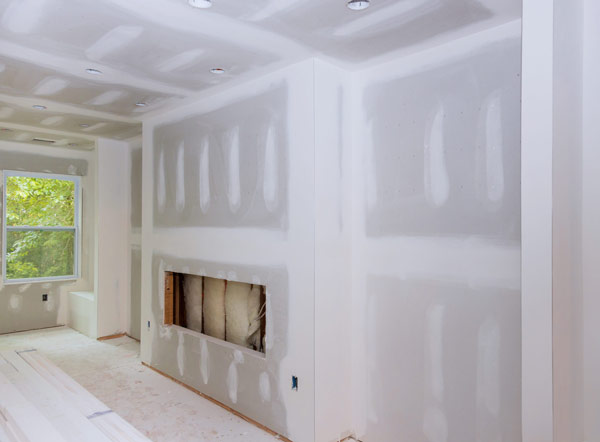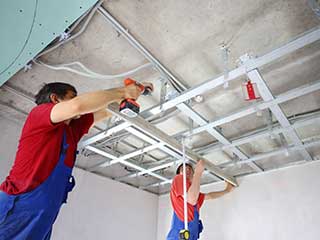Step-by-Step Approaches to Getting Flawless Drywall Fixing and Installation
Accomplishing remarkable drywall repair and setup needs a methodical strategy. It entails understanding the different sorts of drywall and the tools necessary for the task. Proper area preparation is important before starting any type of work. Interior Painting. Each step, from patching holes to mounting brand-new sheets, needs focus to information. The procedure does not finish with installment; finishing techniques are crucial for a polished look. The next actions will assure a smooth outcome, yet what exactly do they entail?
Understanding Drywall Types and Tools Needed

The installation devices are equally crucial. An energy blade is vital for cutting drywall sheets, while a drywall saw can help in making accurate cuts for components or electrical outlets. T-squares ensure accurate measurements, and drywall screws or nails protect the panels to wall studs. In addition, a drywall lift can promote the installation of large sheets, minimizing physical pressure. Experience with these devices and kinds significantly adds to the performance and quality of drywall projects.
Preparing the Area for Repair or Installment
Preparing the location for drywall repair service or setup is important to guarantee a efficient and smooth procedure. Initially, the surrounding space should be cleared of furnishings and various other barriers to supply enough functioning area. This not only assures safety yet additionally stops damage to personal belongings. Next, it is necessary to cover the floor with decline towels to catch any debris or dust produced throughout the job.
In addition, the wall surfaces must be checked for any loosened paint or wallpaper that may interfere with attachment. Getting rid of these components develops a clean surface for the brand-new drywall. Prior to beginning, it is advisable to transform off power to electric outlets or components around. Ensuring adequate lights in the office will certainly better improve visibility and emphasis throughout the repair work or installment process. drywall contractors. By carefully preparing the location, one prepares for a successful drywall task
Step-by-Step Process for Patching Holes

Covering openings in drywall needs a methodical technique to ensure a seamless fixing. The very first step entails assessing the size of the hole. For little holes, a patching compound may be adequate, while bigger openings demand a spot. Next off, the damaged location must be cleansed and prepared by eliminating any kind of loose debris.
For tiny openings, using spackling substance with a putty blade is suggested, smoothing it over the opening and feathering the sides. As soon as dry, sanding the location assures a smooth coating. For bigger openings, a drywall patch ought to be cut to dimension, positioned over the hole, and safeguarded with screws. After setting up the patch, the very same spackling process is duplicated, complied with by sanding.
Ultimately, the patched area has to be keyed and painted to match the surrounding wall surface. This precise procedure ensures a professional look and prolongs the lifespan of the repair service.
Installing New Drywall Sheets: A Comprehensive Overview
Setting up brand-new drywall sheets calls for cautious planning and execution to assure a visually attractive and sturdy surface. The location has to be gauged accurately to establish the number of sheets needed. It is important to pick the ideal thickness, typically 1/2-inch for indoor walls and 5/8-inch for ceilings or fire-rated applications.
Next, the studs or structure should be examined for any irregularities, seeing to it they are lined up and correctly spaced. When putting the drywall sheets, they must be positioned horizontally to reduce seams and enhance architectural honesty. A drywall lift can be beneficial for overhead installations.
Fastening the sheets with drywall screws at suitable intervals ensures a secure installation. It is essential to countersink the screws slightly listed below the surface area to prepare for the ending up procedure. Following these guidelines will cause a solid foundation, all set for the following action in drywall completing.
Finishing Touches: Insulation, Mudding, and Sanding Strategies
As soon as the drywall sheets are safely fastened, the emphasis changes to the finishing touches that will give a refined appearance. This process starts with taping, utilizing either paper or fiberglass harmonize tape to cover the seams between sheets. The tape assures a smooth shift, minimizing the risk of cracking. Adhering to taping, mudding is essential; a joint substance is used over the tape to load voids and produce a smooth surface area. Typically, multiple layers are essential, every one feathery out additionally than the before lessen exposure.
After adequate drying time, sanding is the final step in accomplishing a perfect surface. A fine-grit sandpaper is used to smooth the dried out substance, ensuring there are no imperfections or bumps. Attention to information during this stage is considerable, click here as it significantly affects the total look of the wall surface. The end outcome need to be an even, professional-looking surface all set for priming and painting.
Often Asked Inquiries
Exactly how Do I Choose the Right Drywall Density for My Job?
To select the right drywall density, think about the project's objective, place, and architectural demands. Standard densities include 1/2-inch for basic use and 5/8-inch for fire-rated applications, making certain durability and conformity with building codes.

Can I Install Drywall Over Existing Drywall?
Yes, installing drywall over existing drywall is feasible. Nonetheless, it is crucial to ensure the underlying surface is totally free and secure from damage. Correct attachment and consideration of density are vital for a successful installment.
What Are the very best Practices for Drywall Disposal?
The best techniques for drywall disposal include reusing when possible, utilizing regional waste management solutions, and following standards for dangerous materials if appropriate. Interior Painting. Properly labeling and securing waste warranties compliance and safety and security during disposal
Just how Long Should I Wait On Mud to Dry Prior To Sanding?
Commonly, one ought to wait 24-hour for drywall mud to completely dry prior to fining sand. Nevertheless, drying out time can vary based on moisture and temperature level, so looking for a firm appearance is suggested prior to proceeding.
Exist Eco-Friendly Drywall Options Available?
Yes, eco-friendly drywall alternatives are offered. These alternatives usually use recycled materials, low-VOC adhesives, and lasting production methods, lowering environmental influence while providing reliable insulation and sturdiness for various building and construction and remodelling tasks.
An utility blade is crucial for reducing drywall sheets, while a drywall saw can assist in making precise cuts for electrical outlets or fixtures. Preparing the area for drywall repair or setup is crucial to ensure a smooth and reliable procedure. Patching openings in drywall calls for a methodical technique to assure a smooth repair service. Setting up brand-new drywall sheets needs cautious planning and execution to guarantee a sturdy and aesthetically appealing coating. Yes, setting up drywall over existing drywall is possible.